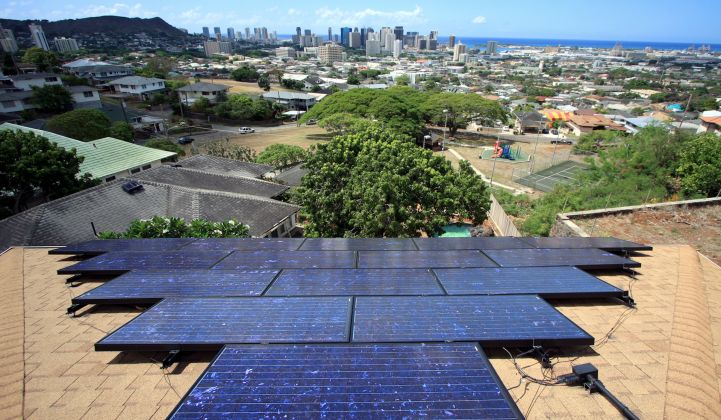The state of Hawaii instituted a mandate that 30 percent of electricity generation must come from renewable sources as of 2020. But the state's utilities have already exceeded that figure as they move toward a completely clean energy system.
Hawaiian Electric, the state's largest utility, reported this month that its 2020 generation mix reached 34.5 percent renewable across Oahu, Hawaii Island and Maui. Renewable production rose 13 percent from 2019.
That growth coincided with lower demand stemming from the coronavirus pandemic, which meant the denominator of the market-share fraction was smaller than normal. But even if consumption patterns had been the same as during pre-pandemic times, the utility would have beaten the target with 32 percent renewable electricity, the company said.
"It’s a culmination of so much work that we’ve put into building our renewable portfolio," said spokesperson Shannon Tangonan. "We’re reaping the benefits of staying true to the goals [and] keeping our eyes set on the 100 percent goal."
The Kauai Island Utility Cooperative (KIUC) has not yet filed its final 2020 numbers, but spokesperson Beth Tokioka told Greentech Media that the results are likely to show that its electricity mix is more than 60 percent renewables. That exceeds both the state's 2020 requirement and KIUC's strategic goal of 50 percent renewables by 2023.
Faster than expected
The power sector has seen a number of supposed impossibilities fall by the wayside in recent years. First to go was the assumption that states could never commit themselves to 100 percent carbon-free electricity. Hawaii kicked off that trend in 2015 with a law that set the deadline at 2045. California later followed suit, as did numerous other states.
President Joe Biden campaigned on a phaseout of fossil-fueled electricity by 2035, though it remains to be seen how he will attempt to pass that policy.
Such goals only matter if they lead to tangible deployments. That's where Hawaii's progress is a valuable case study. After setting the timeline to decarbonize, the power companies found they could move faster than initially expected. Indeed, Hawaiian Electric is well on its way to the state's 40 percent target for 2040, and KIUC is already well past that.
Hawaiian Electric is hopeful it will reach 40 percent ahead of schedule, Tangonan noted.
"As we get closer to 100 percent, it will get more difficult," Tangonan said. "We’re an island state. Land is very scarce. There are a lot of other elements we have to be mindful of."
Rooftop solar in the lead
The expense of shipping coal, fuel oil and diesel to Hawaii to burn in conventional power plants made the economics of solar favorable there earlier than on the mainland. Rapidly falling solar and battery costs allowed developers to make increasingly attractive proposals. A groundbreaking set of large solar and battery projects has been awarded and will be built in the coming years.
But the breakdown of where Hawaiian Electric's power came from shows that consumers led the way.
Nearly half of Hawaiian Electric's renewable production came from "customer-sited, grid-connected" renewables, which predominantly consists of rooftop solar. The next largest contributor was wind, followed by large-scale solar and biomass. Biofuels, hydro and geothermal round out the renewable mix, in descending order. Deployments of customer-sited renewables totaled 65.6 megawatts of new capacity last year, far more than any utility-scale projects.
Cheap solar can only carry a grid so far, which is the impetus behind Hawaiian Electric's plan to switch on large-scale battery plants to store solar power and deliver it after the sun goes down. And 78 percent of new rooftop solar installations come with a battery, Tangonan noted.
KIUC has already built several major battery plants and is turning next to a solar-powered pumped hydro storage facility, which promises to be able to deliver clean power through the night. If that project comes to fruition, it will bring Kauai to 80 percent renewable power by the mid-2020s, KIUC has said previously.
For more energy storage insights, follow Julian on Twitter and subscribe to his free weekly newsletter, Bright Ideas.



